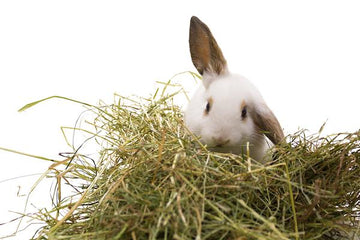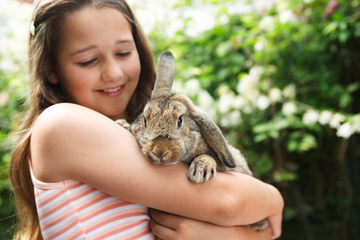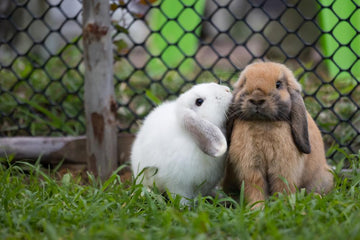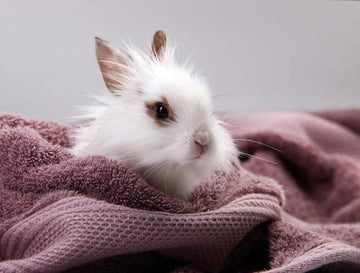Rabbit Cage Essentials: 8 Tips for a Comfortable Habitat
Your rabbit deserves a safe, comfortable, and engaging home. Whether your furry friend spends most of their time inside the cage or uses it as a nighttime retreat, understanding rabbit cage essentials is key to keeping them happy and healthy.
Click Here For a Guide to Creating the Ideal Litter Box.

From choosing the right size to including interactive toys, creating the perfect cage setup involves thought and care. In this guide, we'll explore everything you need to know to make your rabbit's space inviting and practical.
#1 Rabbit Cage Essentials: Space and Setup
The first thing to consider is size. Rabbits are active animals that need plenty of room to hop, stretch, and move. A cage should be at least six times the length of your rabbit's body. Many store-bought cages are too small for this, but don't worry—you have options.
One popular alternative is creating a custom cage using wire storage cubes and zip ties. This allows you to design a habitat tailored to your rabbit's needs. For multi-level setups, consider adding ramps or platforms for extra exploration. Check out this guide for detailed instructions on building a DIY rabbit condo.
#2 Protect Your Rabbit’s Feet
Wire flooring is common in commercial cages but poses risks to your rabbit's sensitive feet. Walking on wire can lead to painful conditions like sore hocks. Instead, opt for a solid, flat surface lined with rabbit-safe materials like hay, shredded paper, or Food Grade Bedding. These materials protect your rabbit's paws and help absorb odors.
#3 Must-Have Rabbit Cage Accessories
1. Litter Box
Rabbits often relieve themselves while eating, so placing a litter box under the hay feeder is a practical choice. Avoid using clumping cat litter, which is harmful if ingested. Instead, choose a rabbit-safe litter made from paper or wood pellets.
2. Food and Water Containers
Fresh water is essential. You can use either a heavy ceramic bowl or a hanging water bottle. Bowls mimic natural drinking habits but can become contaminated easily. Hanging bottles are cleaner but require regular maintenance to avoid clogging. For food, a sturdy dish works best for pellets, while a hay rack keeps hay off the cage floor.
3. Cozy Resting Spot
Rabbits love having a quiet, comfortable place to relax. Provide a soft bed, fleece blanket, or even a small box lined with hay. Make sure all materials are safe if your rabbit decides to nibble on them.
#4 Interactive Enrichment: Toys and Chewable Items
Boredom can lead to stress and destructive behavior, so keeping your rabbit entertained is crucial. Include toys like wooden blocks, woven balls, or cardboard tubes. These items engage their minds and support their natural chewing instincts. If you’re feeling creative, try these DIY toy ideas.
Chewable items like untreated wood sticks or hay cubes help wear down your rabbit's teeth, which grow continuously. Make sure any items you provide are free from harmful chemicals or coatings.
#5 Creating a Sense of Security
Rabbits are prey animals, meaning they can be easily startled by loud noises or sudden movements. Including a hiding spot in their cage gives them a place to retreat when they feel scared. A small cardboard box or a commercially made rabbit house works well for this purpose.
#6 Maintaining a Clean Cage
Cleanliness is a major part of rabbit care. Litter boxes should be emptied daily, and bedding should be replaced weekly. Use a solution of vinegar and water (4:1 ratio) to disinfect surfaces and eliminate odors. Always rinse and dry the cage thoroughly before replacing any materials.

For more guidance, visit our blog on rabbit litter box care. A clean cage not only keeps your rabbit healthy but also makes your home more pleasant.
#7 Dietary Essentials
A rabbit's diet is closely tied to their overall health. Grass hay, such as Timothy Hay, should make up the bulk of their daily intake. Younger rabbits under seven months can have Alfalfa Hay, but adult rabbits need grass hay to avoid obesity and urinary tract problems.
Place hay in a feeder to keep it clean and dry. Fresh vegetables and a small amount of high-quality pellets should complement their diet. Learn more about transitioning to the best hay for your rabbit.
#8 Cage Location: Where Should Your Rabbit Live?
Placement is important when setting up your rabbit's cage. Avoid areas with direct sunlight or extreme drafts, as these can harm your rabbit. If the cage is outdoors, ensure it's predator-proof and offers plenty of shade. Indoors, place the cage in a quiet but social area where your rabbit can feel part of the family without being overwhelmed by activity.

Bonus Tip: Enriching Your Rabbit’s Life
Providing a clean, spacious, and engaging cage is just the first step. Rabbits also thrive on regular interaction and exercise. Allow them daily time outside the cage to explore and bond with you. Supervised playtime boosts their mental and physical health and strengthens your relationship with your furry friend.
Final Thoughts on Rabbit Cage Essentials
Designing the perfect rabbit cage involves careful planning and attention to detail. From spacious enclosures to engaging toys, each element plays a role in your rabbit's well-being. By following these rabbit cage essentials, you'll create a habitat where your pet can live happily and healthily.

Rabbit Hay Allergies: Symptoms and Solutions

Tips on How to Have a Rabbit Becoming Friendly











